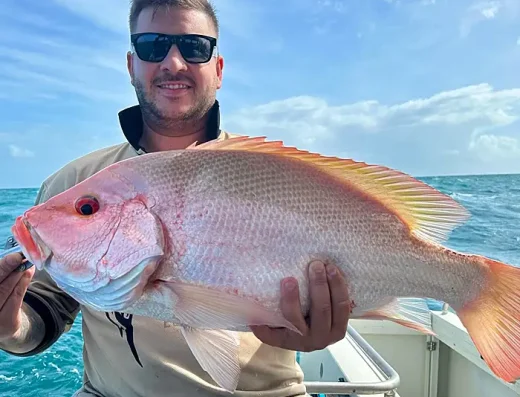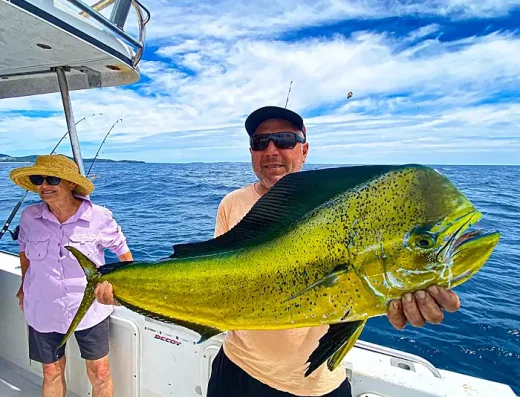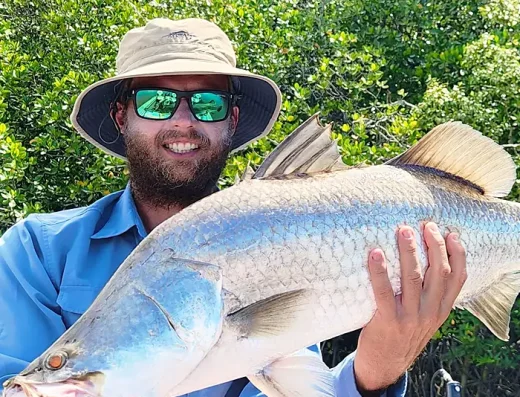Charter Fishing in Queensland
Queensland offers fishing across offshore reefs and shoals, tidal estuaries and surf beaches, and freshwater rivers, lakes, and impoundments.
TrustedFish connects anglers with proven local captains in Queensland, Australia —no commissions, no pay-to-play listings, no BS. Every charter on our platform is invite-only, vetted for skill, local knowledge, and reputation. If they’re listed, they’ve earned it.
Top Rated Charters in Queensland
Queensland Fishing Guide
Queensland is massive, and the fishing shifts as you travel north or south. Offshore, the Great Barrier Reef dominates the scene. Coral trout, red emperor, nannygai, and GTs work the reef edges, while marlin, tuna, and mahi push along the bluewater currents. Cairns is the black marlin capital each spring, where boats troll big baits along the Ribbon Reefs. Gladstone and Mackay are gateways to the Capricorn reefs, where year-round bottom fishing for trout and reds is the main game.
Inshore is just as productive. Mangrove creeks and river systems are full of barramundi, threadfin salmon, mangrove jack, and grunter. Beaches and flats offer queenfish, whiting, and dart, while the Fitzroy River near Rockhampton and the Gulf rivers around Weipa hold some of the best wild barra stocks in the country.
Freshwater is another specialty here. Stocked impoundments like Tinaroo, Kinchant, and Awoonga are famous for monster barramundi, often pushing 50 pounds or more. The western rivers running into the Gulf hold wild sooty grunter and barra, giving inland anglers plenty of targets.
Seasonal changes are easy to follow. The dry season through winter and spring means calm seas and excellent reef fishing. When the wet kicks in during summer, northern rivers flood and barra pile into creeks and billabongs. Mackerel and tuna push down the reef edges in warmer months, while autumn offers one of the most balanced bites, with both reef and estuary fish at their peak.
Charters operate from nearly every coastal hub — Cairns, Townsville, Mackay, Gladstone, Hervey Bay, and Brisbane in the south. Trips range from half-day estuary runs to full-day reef charters, plus extended liveaboards that push deep into the Ribbon Reefs or Coral Sea. Offshore boats include large sportfishers and catamarans, while estuaries and impoundments are worked by center consoles and skiffs. Tactics cover the lot: trolling for marlin and mackerel, bottom fishing and jigging reefs, casting lures and flies for barra and GTs, or walking the banks with surface lures for impoundment barra.
Fishing Seasons in Queensland
Spring
Spring brings warming water, and the inshore creeks fire with barra, mangrove jack, and threadfin. Offshore, calm weather allows long runs to the reef, where coral trout and red emperor feed aggressively. Spanish mackerel and tuna are common along reef drop-offs, while freshwater barra in the impoundments push shallow and take surface lures.
Summer
Summer rains flood the northern rivers, and barra push into creeks and lagoons. Offshore currents bring black marlin, tuna, and mackerel along the reef, especially off Cairns and Townsville. Estuaries in the south fish well for whiting and flathead, while beaches produce dart and bream. Early mornings and evenings are best to beat the tropical heat.
Fall
Fall is one of the steadiest fishing seasons. Offshore, the mackerel and tuna are strong, reef fishing stays consistent, and estuaries are full of actively feeding barramundi and jacks. Gulf rivers settle after the rains, and inland fishing improves. This is also a prime time for Hervey Bay, with longtail tuna and juvenile marlin feeding close to shore.
Winter
Winter is dry, calm, and ideal for offshore reef trips. Coral trout, red emperor, and snapper are common catches, while tailor and bream run strong in southern estuaries and surf beaches. Northern barra slow down with the cooler water, but queenfish and GTs stay active along creek mouths and flats. In freshwater, bass and sooty grunter bite well in rivers and impoundments.
Top Fishing Regions
Cairns
Cairns is the epicenter of Queensland’s heavy-tackle black marlin fishery. Each spring, the Ribbon Reefs produce giant marlin along with Spanish mackerel, mahi, and tuna. Inshore estuaries around Cairns also hold barra, jacks, and queenfish. Both day trips and multi-day liveaboards operate from the marina.
Townsville
Townsville offers access to central Great Barrier Reef fishing, with coral trout, red emperor, and nannygai on the reefs. Spanish mackerel school around reef channels in winter. The Ross River and local creeks provide barramundi and threadfin salmon year-round.
Gulf of Mexico (Louisiana & Texas)
Mackay
Mackay is best known for trophy impoundment barra in Kinchant and Eungella dams. Offshore reefs provide trout and red emperor, while estuaries like the Pioneer River hold jacks and threadfin.
Gladstone
Gladstone is the launch point for the Capricorn Reef group. Offshore fishing targets trout, red emperor, and pelagics, while the Boyne River and Lake Awoonga are famous for big barra.
Hervey Bay
Hervey Bay is unique for its run of juvenile black marlin each spring. The bay also produces longtail tuna, trevally, and queenfish, while flats fishing offers bream and whiting.
Brisbane
Brisbane anglers work both offshore reefs and inshore waters. Offshore grounds produce snapper, mackerel, and pearl perch, while the Brisbane River is known for threadfin salmon and mulloway.
Cape York
Cape York remains one of the most untouched fisheries in Australia. Creeks and flats hold barramundi, queenfish, and GTs, while shoals and reefs offshore provide trout and mackerel.
Weipa sits on the Gulf of Carpentaria and is known for barramundi, threadfin, and queenfish. Offshore reefs and shoals produce GTs, coral trout, and mackerel
Top Gamefish in Queensland
- Black Marlin – 200 to 1,200 lb. Found off Cairns and the Ribbon Reefs, peak September to December, targeted by trolling large baits and lures.
- Spanish Mackerel – 15 to 70 lb. Caught along reef edges and headlands, best May to October, taken on trolled baits or lures.
- Coral Trout – 5 to 25 lb. Found across the Great Barrier Reef, peak in winter and spring, targeted with bottom baits or jigs.
- Barramundi – 10 to 60 lb. Found in northern rivers and impoundments, best February to May, targeted with lures, flies, or live baits
- Giant Trevally – 20 to 100 lb. Common on reef edges and flats, best in summer and fall, taken with poppers and stickbaits.
- Threadfin Salmon – 10 to 40 lb. Found in tidal rivers from Brisbane north, peak in fall, caught with live prawns and soft plastics.
- Red Emperor – 10 to 40 lb. Found on deeper reefs off central Queensland, best in winter, caught with cut baits and heavy jigs.
- Longtail Tuna – 10 to 40 lb. Found in Hervey Bay and northern coastlines, peak in fall and spring, targeted with casting lures into surface schools
Queensland Fishing FAQs
Do you need a license to fish in Queensland?
No license is required for saltwater, but a permit is needed for stocked freshwater dams under the Stocked Impoundment Permit Scheme.
When is the best time to fish in Queensland?
Reef fishing is best from May to September, while barra fishing peaks late summer through fall. Timing depends on the species and region you’re targeting.
What are the top fishing destinations in Queensland?
Cairns, Townsville, Mackay, Gladstone, Hervey Bay, Cape York, and Weipa are the most popular fishing hubs across the state.
How long are typical charters in Queensland?
Day trips are common for reefs and estuaries, while marlin and remote reef trips often run three to ten days aboard liveaboards.
What gear is recommended for Queensland fishing?
Light tackle spin gear works estuaries, while heavy tackle is needed offshore for marlin and GTs. Many charters supply gear, but anglers often bring personal lures or fly setups.
Are there closed seasons in Queensland?
Yes, barramundi are closed from November through January, and reef species have strict bag and size limits. Always check current rules.
Is fishing in Queensland good for families?
Yes, estuary and nearshore trips are safe and productive for families. Many operators run family-friendly charters targeting flathead, whiting, and bream.
Can you fish from shore in Queensland?
Yes, beaches, rock walls, and estuary banks provide good fishing. Species include tailor, bream, queenfish, and whiting.
How much do charters cost in Queensland?
Half-day trips average AUD $150–$250 per person, full-day reef trips AUD $250–$400, while extended liveaboards cost several thousand depending on trip length.



